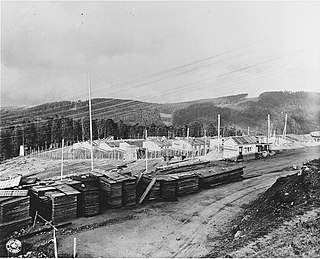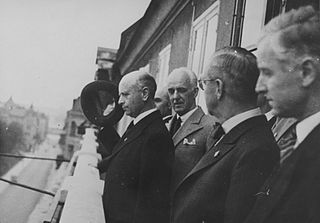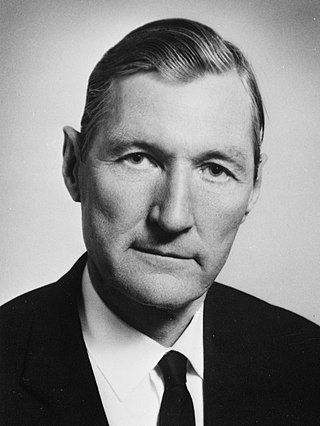Related Research Articles

Natzweiler-Struthof was a Nazi concentration camp located in the Vosges Mountains close to the villages of Natzweiler and Struthof in the Gau Baden-Alsace of Germany, on territory annexed from France on a de facto basis in 1940. It operated from 21 May 1941 to September 1944, and was the only concentration camp established by the Germans in the territory of pre-war France. The camp was located in a heavily forested and isolated area at an elevation of 800 metres (2,600 ft).

Ragnar Sigvald Skancke was the Norwegian Minister for Church and Educational Affairs in Vidkun Quisling's Nasjonal Samling government during World War II. Shot for treason in the legal purges following the war, he remains the last person executed in Norway.

The Dachau trials, also known as the Dachau Military Tribunal, handled the prosecution of almost every war criminal captured in the U.S. military zones in Allied-occupied Germany and in Allied-occupied Austria, and the prosecutions of military personnel and civilian persons who committed war crimes against the American military and American citizens. The war-crime trials were held within the compound of the former Dachau concentration camp by military tribunals authorized by the Judge Advocate General of the U.S. Third Army.

Siegfried Wolfgang Fehmer was a German SS officer during World War II. He was stationed in Norway during the occupation by Nazi Germany, and by the end of the war he was heading the Oslo branch of the Gestapo from its headquarters in Victoria Terrasse, Oslo. Along with Josef Terboven, Fehmer was considered one of the most despised members of the German occupation forces in Norway.

Ernst Josef Albert Weiner was a German SS-Hauptsturmführer during World War II. He was most noted for his role in Operation Blumenpflücken during the occupation of Norway by Nazi Germany.
Albert Wiesener was a Norwegian lawyer.

Sigurd Emil Roll was a Norwegian diplomat and former sprinter who was executed during the occupation of Norway by Nazi Germany. His brother William was a US diplomat.

Capital punishment in Norway has been constitutionally prohibited since 2014. Before that, it had been fully abolished in 1979, and earlier, from 1905, the penal code had abolished capital punishment in peacetime.
Frank Olsen was a Norwegian resistance member who was executed during the occupation of Norway by Nazi Germany.
Kåre Adolf Olafsen was a Norwegian resistance member who was executed during the occupation of Norway by Nazi Germany.
Storm Willads Weinholdt was a Norwegian resistance member who was executed during the occupation of Norway by Nazi Germany.
Henry Gundersen was a Norwegian resistance member who was executed during the occupation of Norway by Nazi Germany.

The Norwegian Legation in Stockholm played a significant role during the Second World War. Until 9 April 1940 the legation consisted of four persons, and at the end of the war about 1,100 persons were connected to the legation. Refugee cases were among the legation's most central tasks. In 1941 a military office was established, and this was later split into separate offices for intelligence, and for Milorg related cases.

The Quisling regime, or Quisling government are common names used to refer to the fascist collaboration government led by Vidkun Quisling in German-occupied Norway during the Second World War. The official name of the regime from 1 February 1942 until its dissolution in May 1945 was Den nasjonale regjering. Actual executive power was retained by the Reichskommissariat Norwegen, headed by Josef Terboven.

Johannes Bratt Andenæs, often shortened to Johs. Andenæs was a Norwegian jurist. He was a professor of jurisprudence at the University of Oslo from 1945 to 1982, and served as rector from 1970 to 1972.
Operation Blumenpflücken was a counter-resistance operation in occupied Norway, planned and carried out by the Gestapo/Sicherheitspolizei in 1944 and early 1945.
The milk strike was a strike in Nazi-occupied Oslo on 8 and 9 September 1941. It led to strong reprisals from the German occupiers, in the form of martial law, court-martial, mass arrests, two executions and several long-term jail sentences.
MTB 345 was an experimental motor torpedo boat constructed in 1941, which saw limited service with the Royal Navy before being transferred to the exiled Royal Norwegian Navy on 16 March 1943. She sailed with the Royal Norwegian Navy for three months in 1943, until captured by German forces on 28 July 1943, during her second mission to the coast of occupied Norway. Two days after their capture, the crew of MTB 345 were executed by the Germans based on Hitler's Commando Order. Following their capture of MTB 345, the Germans pressed the motor torpedo boat into Kriegsmarine service, renaming her SA 12. The fate of SA 12 since December 1943 is unknown.
Hans Latza (1908–1975) was a German SS-Obersturmbannführer. He served as SS-judge in Munich from 1939 to 1940, in Prague in 1940, and in Oslo from 1940 to 1945. Latza was the principal judge at SS- und Polizeigerat in Norway. He was responsible for more than 25 death sentences. In the legal purge in Norway after World War II Latze and two co-judges were prosecuted for war crimes for their role when five persons had been sentenced to death in a court-martial reprisal following the assassination of police chief Karl Marthinsen, but Latza was acquitted by the Supreme Court in 1948.
Alfred Zeidler was a German Schutzstaffel (SS) officer who served Nazi Germany in World War II. From 1942 to 1945, he was Lagerkommandant of the Grini detention camp in Norway during the German occupation. Although sentenced to lifelong forced labour after the war, Zeidler was released in 1953. Details of his later life are unknown.
References
- ↑ Trial of Hauptsturmführer Oscar Hans Archived 2012-07-28 at the Wayback Machine , Law Reports of Trials of War Criminals.
- ↑ Trial of Hauptsturmführer Oscar Hans Archived 2012-07-28 at the Wayback Machine , Law Reports of Trials of War Criminals.
- ↑ Skarsem, Øyvind and Flyum Ola: Rinnanjævel, Aschehoug 2011, ISBN 978-82-03-29319-1, p. 48.
- ↑ Law Reports of Trials of War Criminals, www.loc.gouv, retrieved 21 April 2014.
- ↑ Bohn, Robert (editor), Deutschland, Europa und der Norden. HMRG, Beihefte, vol. 6, Stuttgart 1993, p. 121, footnote 48.
- ↑ "Curiohaus". www.kz-gedenkstaette-neuengamme.de. Retrieved 2023-04-29.